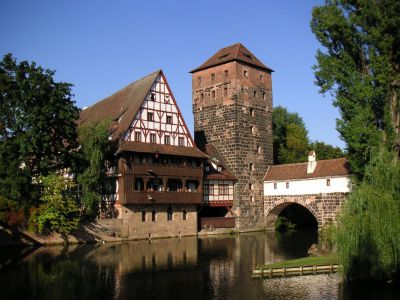Weinstadel (Wine House), Nuremberg
The Wine Store (Weinstadel) in Nuremberg is a stunning medieval building constructed between 1446 and 1448. Initially a leprosarium, it later served as a wine depot. Today, it's recognized as Germany's largest half-timbered structure, stretching 48 meters along the Pegnitz River. Its striking rust-brown and white timber frame, alongside the scenic Hangman's Bridge and golden weeping willows, makes it a remarkable architectural site.
In its early days, the Wine Store served a compassionate purpose as a hospice for lepers. During the Easter period, lepers were permitted into the city for three days, receiving food, clothing, and medical care within its walls. By the late 16th century, around 1571, the building transitioned into a wine warehouse, which is reflected in its name 'Weinstadel'-German for 'wine storage'. Over the centuries, it has also functioned as a workhouse, spinnery, and lodging for impoverished families.
Significantly damaged during World War II bombings, the Wine Store underwent a transformation in the 1950s when it was repurposed as a student residence for the University of Erlangen-Nuremberg. This conversion, while preserving the exterior's historic charm, significantly altered the building’s internal structure.
Today, the Wine Store remains one of Nuremberg’s most significant historical monuments and a highlight in the city's old town. It stands as a testament to the city’s rich history and resilience, providing a romantic and picturesque experience for visitors and locals. The area's historical significance is further highlighted by its proximity to the former “penultimate city wall” and a fortified bridge, which once connected the two halves of the city across the Pegnitz River. This blend of rich history, stunning architecture, and romantic ambiance makes the Wine Store a must-visit location in Nuremberg.
In its early days, the Wine Store served a compassionate purpose as a hospice for lepers. During the Easter period, lepers were permitted into the city for three days, receiving food, clothing, and medical care within its walls. By the late 16th century, around 1571, the building transitioned into a wine warehouse, which is reflected in its name 'Weinstadel'-German for 'wine storage'. Over the centuries, it has also functioned as a workhouse, spinnery, and lodging for impoverished families.
Significantly damaged during World War II bombings, the Wine Store underwent a transformation in the 1950s when it was repurposed as a student residence for the University of Erlangen-Nuremberg. This conversion, while preserving the exterior's historic charm, significantly altered the building’s internal structure.
Today, the Wine Store remains one of Nuremberg’s most significant historical monuments and a highlight in the city's old town. It stands as a testament to the city’s rich history and resilience, providing a romantic and picturesque experience for visitors and locals. The area's historical significance is further highlighted by its proximity to the former “penultimate city wall” and a fortified bridge, which once connected the two halves of the city across the Pegnitz River. This blend of rich history, stunning architecture, and romantic ambiance makes the Wine Store a must-visit location in Nuremberg.
Want to visit this sight? Check out these Self-Guided Walking Tours in Nuremberg. Alternatively, you can download the mobile app "GPSmyCity: Walks in 1K+ Cities" from Apple App Store or Google Play Store. The app turns your mobile device to a personal tour guide and it works offline, so no data plan is needed when traveling abroad.
Weinstadel (Wine House) on Map
Sight Name: Weinstadel (Wine House)
Sight Location: Nuremberg, Germany (See walking tours in Nuremberg)
Sight Type: Attraction/Landmark
Sight Location: Nuremberg, Germany (See walking tours in Nuremberg)
Sight Type: Attraction/Landmark
Walking Tours in Nuremberg, Germany
Create Your Own Walk in Nuremberg
Creating your own self-guided walk in Nuremberg is easy and fun. Choose the city attractions that you want to see and a walk route map will be created just for you. You can even set your hotel as the start point of the walk.
Hitler's Nuremberg Tour
Despite Nuremberg's storybook appearance, the city's not so distant past is rather dark. Back in 1933, amid the rise of the Third Reich, the Nazis worked really hard to leave their stamp on the city, prettifying it and renovating the architecture in a bid to accommodate their massive rallies and bombastic military parades.
In fact, no other city in Germany is more intertwined with the... view more
Tour Duration: 2 Hour(s)
Travel Distance: 4.9 Km or 3 Miles
In fact, no other city in Germany is more intertwined with the... view more
Tour Duration: 2 Hour(s)
Travel Distance: 4.9 Km or 3 Miles
Nuremberg Introduction Walking Tour
The most "German" of all cities in Germany, Nuremberg has witnessed many historic events in its lifetime. Sadly, the first thing immediately associated with Nuremberg is the rise of the Third Reich, the Nazi rallies, and the postwar trials over the Nazi leaders. Indeed, the city was favored by Hitler, who planned to build here a grandiose architectural complex for his party.
... view more
Tour Duration: 2 Hour(s)
Travel Distance: 2.8 Km or 1.7 Miles
... view more
Tour Duration: 2 Hour(s)
Travel Distance: 2.8 Km or 1.7 Miles
Nuremberg Old Town Walking Tour
The historical center of Nuremberg, Old Town (German: Altstadt) is easily differentiated from other parts of the city. Divided in two by the Pegnitz River, the district represents a complex architectural ensemble with a maze of historical lanes (e.g. Weissgerbergasse) packed with half-timber houses, linked by centuries-old bridges, such as Maxbrücke, and set against the picturesque backdrops of... view more
Tour Duration: 3 Hour(s)
Travel Distance: 3.8 Km or 2.4 Miles
Tour Duration: 3 Hour(s)
Travel Distance: 3.8 Km or 2.4 Miles






